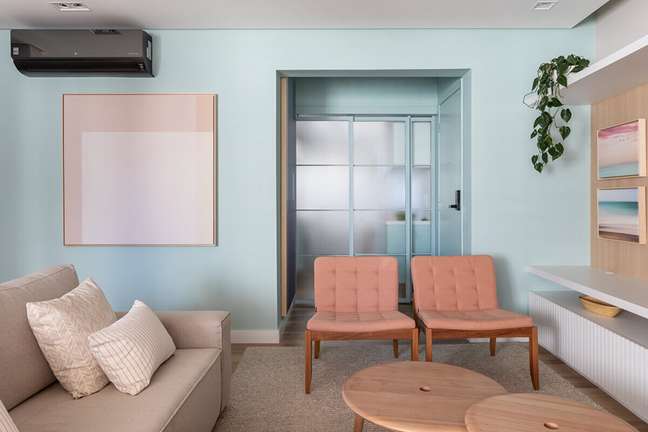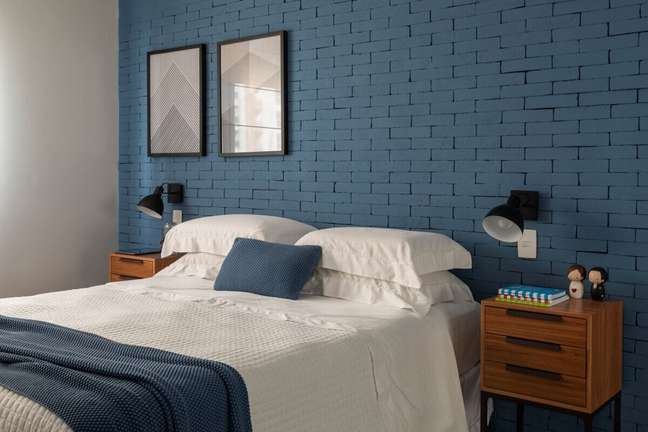The type of paint, finish and texture also affect the result of the paint.
The wall painting phase is a recurring issue, since the choice of paint goes far beyond the choice of colors: before defining the material, other important requirements must be considered. Nowadays it’s not enough to just open the jar, prepare the paint and apply it to the wall. With a variety of products for different types of surfaces, the right paint translates into the expected aesthetics of the furniture, combines with the lifestyle of the residents and contributes to the longevity of the job.

“Before thinking about painting, we always analyze the state of the surface that will be painted. It is essential that the wall is regularized, sanded and with the perfect finish. These precautions contribute to the result, as evidenced by the satin and glossy paints. opaque acrylic, more resistant and washable with a sponge “, explains the architect Marina Carvalho, who directs the studio that bears her name.
Indoor and outdoor environments
Each type of ink is intended for a specific situation. Among these are whether or not they exude the smell of the material, anti-mold and with antibacterial action, among other specificities found in the construction market. However, it is also necessary to analyze environment it will be applied, inside or outside the property.
Although an exterior paint can also be applied internally, the opposite can end up not giving a satisfactory result. “In the internal part of the house we can rely on latex or acrylic. In the external part, the recommended thing is to work only with acrylic”, advises the professional.
Paint in wet areas
When it comes to painting a damp environment like laundries, bathrooms and kitchens, there are two types of paint suitable for the environments. The first of these is acrylic, which offers greater resistance to moisture – some brands have mold protection and are washable.
To ensure longer product life, in some cases it is recommended to use a sealant as a strategy to prepare the surface before painting. Another indication for wet areas are epoxy paints, recognized as the most resistant on the market, with high durability and waterproofing capacity.

THEpaint finish
Each room in the house needs different paint finishes. This wall care goes beyond the aesthetic question, since choose the ideal texture of a surface results in more longevity and fewer headaches. For walls free of imperfections, the most suitable finish is semi-gloss, which offers good resistance in humid areas, preventing the proliferation of mold in the environment, and provides a brilliant texture. “It is great for children’s rooms, as it resists scratches, scrapes and is easy to clean,” Marina says.
The satin finish is another style recommended for humid environments and blends very well with lighter tones. However, touching up this type of finish is a bit more difficult to do: with this, the ideal is that the chosen wall does not get dirty easily.
The matte finish, in turn, is perfect for covering walls with imperfections, as it helps to mask the unevenness of the surface. However, it is not recommended for any type of environment, as it gets dirty easily, is a complicated cleaning and has little resistance to water.
renew the paint
Although the type of paint has a useful life, wear and tear paint renovation it will depend on factors such as climate, sun exposure and form of application, among other issues. However, when good quality paint is used and the walls are preserved from aggression, the paint can be kept for up to 10 years.
According to Marina, the main indicators for a new paint job are factors such as blistering, fading, and flaking. “These ‘symptoms’ show the resident that it is time to renew the painting. I recommend it at least every 5 years,” she advises.
Paint other surfaces with suitable materials
The painting of a house is not limited only to the walls, since the colors in the rooms are also present on other surfaces such as wooden and metal doors. In these cases Marina recommends the use of water-based satin enamel, as the solvent-based product can yellow over time if the paint is white.
The architect is committed to remembering another part of the rooms which is also very important. “We cannot forget the ceiling, because it is as important as the wall. In this area, the best choice it is an opaque latex that has good durability, easy application and is resistant to mold “, concludes the architect.
By Leonardo Sandoval
+The best content in your email for free. Choose your favorite Earth Newsletter. Click here!
Source: Terra
Benjamin Smith is a fashion journalist and author at Gossipify, known for his coverage of the latest fashion trends and industry insights. He writes about clothing, shoes, accessories, and runway shows, providing in-depth analysis and unique perspectives. He’s respected for his ability to spot emerging designers and trends, and for providing practical fashion advice to readers.







